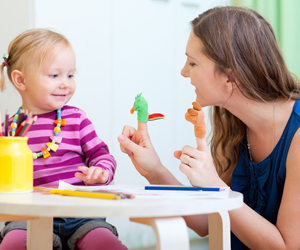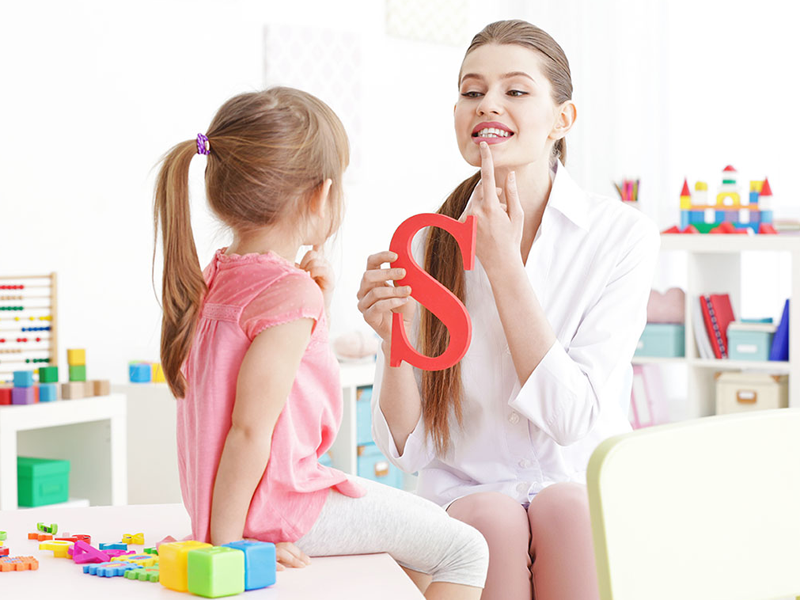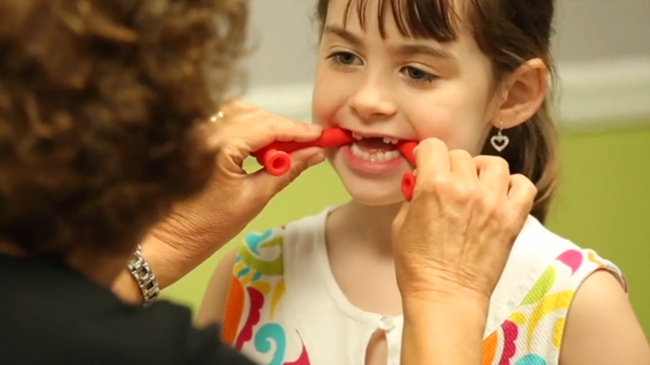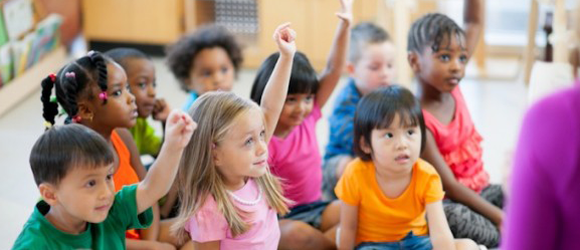

Clinic For Speech Therapy &
Occupational Therapy
Speech and Language Therapy:
The SLP interacts with a child by playing and talking, using pictures, books, objects, or ongoing events to stimulate language development. The therapist may interact with a child one-on-one, in a small group or directly in a classroom to overcome difficulties involved with a specific disorder. And also the SLP may model correct vocabulary and grammar and use repetition exercises to build language skills.
Once an initial assessment is performed, the SLP will determine the best course of action. Interventions vary depending on what communication or feeding and swallowing goals will be targeted. Therefore based on each and every individual the goal program may vary and it may include different components of speech and language. When the SLP begins to work with the child his overall communication may improve as the goal program is focused on in improving his overall communication skills.
An SLP strives to make every therapy session feel like play, especially for the youngest children. To improve speech and language, SLP might have a child play with a baby doll and pretends to feed it, naming and talking about pre-selected or strategically selected food to improve production of certain sounds.

Playing with the doll and practicing targeted sounds is fun and therapeutic for children at the same time. To target a child’s receptive language and/or executive functioning goals, a therapist may create a fun, motivating obstacle course where the child needs to follow specific directions and recall a sequence of events.
Likewise speech and language therapy will mainly focus on improving the child’s communicative abilities in a holistic manner. For example once the child is exposed to speech and language therapy he may politely request for his needs, she may start naming the objects around her, he may actively follow commands that you ask him to follow, she may sing a rhyme with cutest expressions and words, he may shout out loud how a train goes, she may begin to realize the function of each and every object that she uses in her day to day life, he may categorize objects or pictures when many are given together, she may start answering questions and also questioning others, he may show interest in different types of play activities and so on.
An SLP gives parents and children the tools they need to improve their language skills, but therapist says "It’s the time spent using those tools at home and in the children’s natural environment that really creates lasting change". Practicing what is learned at the therapy appointments is just as important as the appointments themselves. Parents should ask the therapist what goals and strategies can be carried over into the home environment to improve speech and language skills.
Articulation Therapy:
When a child’s speech does not sound clear even after 7 or 8 years of age, he is considered to be having Misarticulation. Misarticulation can be simply described as mispronunciation of particular sounds in isolation, syllable, phrase, sentence or conversation level. In order to come over this condition the child is recommended to undergo articulation therapy.
During the assessment, a detailed evaluation of child’s speech will be done using few standardized test materials and then his recorded speech sample will be analyzed bit by bit by the SLP to determine the exact errors that the child exhibits while he speaks. Through the speech sample analysis the SLP will come to a conclusion whether the child is having articulatory errors alone or he is showing the signs of phonological processes.

Based on the child’s baseline the goal program will be designed. The goal program will always be client oriented and client specific. The children may have their own goal program based on each one’s capability. The required number of speech therapy sessions that the child may have to attend, may depend on the severity of the child’s misarticulation.
Articulation, or sound production, exercises involve having the therapist model correct sounds and syllables in words and sentences for a child, often during play activities. Starting with isolation level the SLP may gradually move onto word, phrase, sentence and eventually conversation level respectively. The level of play is age-appropriate and related to the child's specific needs. When play and therapy are combined together you will always get to see a drastic change in children’s behavior as well as in development in speech and other areas of communication.
The SLP may use visual or tactile stimulation methods to make the child understand about how to produce a particular sound accurately. In this case a mirror can be kept in front of the child, so that he gets to see the way each sound is produced. The placement of the speech articulators can be shown easily through this method while the SLP models the sound to the child. Some use tactile cues in order to make the child understand about the sound production. In such conditions the SLP may help the child to feel the vibration of the vocal cords when it comes to a voiced sound. Therefore initially the child’s hand will be placed on the SLP’s throat to feel the vibration and then he may have to place his hand back on his throat while producing the same sound. Through this method the child gets trained in appreciating and discriminating a particular sound from another. Even the production of bilabial (sounds produced using lips i.e., /p/, /b/, /m/) sounds can be easily shown through oral manipulation methods. Likewise different approaches are being used in Articulation therapy which turns to an effective and still an interesting therapeutic approach for individuals with Misarticulation.
Based on the child’s baseline the goal program will be designed. The goal program will always be client oriented and client specific. The children may have their own goal program based on each one’s capability. The required number of speech therapy sessions that the child may have to attend, may depend on the severity of the child’s misarticulation.
Articulation, or sound production, exercises involve having the therapist model correct sounds and syllables in words and sentences for a child, often during play activities. Starting with isolation level the SLP may gradually move onto word, phrase, sentence and eventually conversation level respectively. The level of play is age-appropriate and related to the child's specific needs. When play and therapy are combined together you will always get to see a drastic change in children’s behavior as well as in development in speech and other areas of communication.
The SLP may use visual or tactile stimulation methods to make the child understand about how to produce a particular sound accurately. In this case a mirror can be kept in front of the child, so that he gets to see the way each sound is produced. The placement of the speech articulators can be shown easily through this method while the SLP models the sound to the child. Some use tactile cues in order to make the child understand about the sound production. In such conditions the SLP may help the child to feel the vibration of the vocal cords when it comes to a voiced sound. Therefore initially the child’s hand will be placed on the SLP’s throat to feel the vibration and then he may have to place his hand back on his throat while producing the same sound. Through this method the child gets trained in appreciating and discriminating a particular sound from another. Even the production of bilabial (sounds produced using lips i.e., /p/, /b/, /m/) sounds can be easily shown through oral manipulation methods. Likewise different approaches are being used in Articulation therapy which turns to an effective and still an interesting therapeutic approach for individuals with Misarticulation.
Oral Placement Therapy (OPT):
Oral Placement Therapy is a speech therapy which utilizes a combination of auditory stimulation, visual stimulation and tactile stimulation to the mouth to improve speech clarity.
This is an important addition to traditional speech treatment methods for clients with placement and movement deficits. This particular technique along with traditional speech therapy techniques work out quite effectively in helping children move from being non-verbal to making a few sounds and so forth. It is a tactile-proprioceptive teaching technique which accompanies traditional therapy. Traditional therapy is primarily auditory and visual. And also this technique becomes most useful when helping children with feeding difficulties or food sensitivities.

Clients with motor and/ or sensory impairments benefit from tactile and proprioceptive components because speech is a tactile-proprioceptive act. OPT is used to improve articulator awareness, placement, stability and muscle memory; all of these are necessary for the development of speech clarity.
OPT can be used with clients of many ages and ability levels. It can be incorporated into program plans for many types of communication disorders (eg: Dysarthria, Apraxia of Speech, Down Syndrome, Developmental delays, Voice disorders, fluency disorders and post CVA clients, as well as clients with mild to profound levels of hearing loss).
OPT teaches oral structural placement to clients who cannot produce or imitate speech sounds using traditional auditory or visual input. For these clients, it is critical to expand speech sound production from phonemes and other similar oral movements the client can already produce.
The founder of TalkTools believes that speech is the end result of 4 critical elements of muscle movement:
For further details you can visit the Talk Tools website and learn more about the usage of this specific technique. As well as you may get to know what all tools are used in this therapy approach in order to bring effective changes in the child.
Once a client can produce a targeted speech sound using traditional auditory or visual input, speech therapy can progress in a more typical manner.
Play is to the child what verbalization is to the adult. It is a medium for expressing feelings, exploring relationships, describing experiences, disclosing wishes, and self-fulfillment. The problems children experience do not exist apart from the persons they are. Therefore, play therapy matches the dynamic inner structure of the child with an equally dynamic approach.
In play therapy toys are viewed as the child’s words and play as the child’s language–a language of activity. In play therapy the symbolic function of play is what so important, providing children with a means of expressing their inner world.
.png)
Play therapy lets children sort through complicated feelings and “use play to communicate at their own level and at their own pace, without feeling interrogated or threatened” (British Association of Play Therapists, BAPT). This is a key aspect of play therapy since traditional therapy can often feel intimidating for children (and adults as well), which does not necessarily lead to a conducive environment for self-expression.
The use of toys enables children to transfer anxieties, fears, fantasies, and guilt to objects rather than people. In the safety of the play therapy experience, children explore the unfamiliar and develop a knowing that is both experiential-feeling and cognitive. It can then be said that through the process of play therapy, the unfamiliar becomes familiar, and children express outwardly through play what has taken place inwardly.
In addition to these aspects, the children get to learn the concept of sharing when they are playing with a group of children, to take turns, to interact with their peers, to listen to what others have to say and many more.
A major function of play in play therapy is the changing of what may be unmanageable in reality to manageable situations through symbolic representation, which provides children opportunities for learning to cope.
Therefore in play therapy the therapists allow children to play during sessions, rather than simply sitting with them and asking questions. Play therapy can be nondirective, as in the case of allowing a child to play with sand to relieve stress, or directive, as in the case of having a child tell a story about a family using puppets to learn more about the child’s family dynamics.
Vivikta offers play therapy for children who lag behind in play activities (eg: pretend play, parallel play, and rule based play) and for children who find it difficult to use a variety of toys effectively
Voice Therapy:
Paediatric voice disorders typically have been blamed on vocally “abusive” behaviours, and many practitioners have tended not to provide intervention because they believed that children would “grow out of it.” However, changes in pitch, loudness, and overall vocal quality tend to interfere with communicative abilities.
Recently, research has focused on paediatric voice disorders and the effects of a voice disorder on a child’s life. It has been reported that children and adolescents felt that their voice disorders resulted in negative attention and limited their participation in activities. Most common voice quality problem in children is Dysphonia/ Hoarseness. Voice disorders in children have been shown to have a negative impact on:
Voice therapy is a behavioral intervention technique that makes use of vocal exercises and shows the child who has a voice issue that, how he/ she is using his/ her voice.
Depending on the diagnosis, a number of treatment options are available for paediatric Dysphonia and behavioural voice treatment is generally the recommended treatment for pediatric vocal nodules. Traditional voice treatment typically focuses on vocal hygiene, worksheets, and reducing “abusive” voice behaviours, such as yelling. These approaches, however, have limited effectiveness.
Vocal hygiene and hydration have a role in pediatric voice treatment, but they should not be the only goals. Treatment should focus on directly improving vocal quality and establishing intrinsic motivators for the child to comply with treatment activities.
A variety of behavioural voice treatment approaches that focus on improving vocal technique can be used successfully with children. Typically, techniques used with children are similar to those used with adults, with some modifications: using child-friendly language, incorporating the child’s caregiver into the sessions to help facilitate home practice and carry-over, and scheduling additional sessions to achieve treatment goals.
Children may experience voice related issues due to voice abuse, hormonal changes or related voice disorders. Therefore to overcome it, it is always recommended to attend voice therapy as SLPs know what to do and how to do, since the vocal folds are extremely delicate parts of our larynx. Voice therapy helps the speaker to maintain the appropriate loudness, pitch and quality of the voice during speech.
Pragmatic Group Therapy:
Children with communication disorders often have difficulty in managing routine everyday social skills such as greeting people appropriately or asking for a toy politely. There are rules about when and how you should talk to people. We use facial expressions or gestures to share how we feel. We learn how to let someone know when we change the topic. Knowing and using these rules makes it easier to communicate.

Social communication includes three major skills such as using language for different reasons (Greeting, Informing, Demanding, Promising, Requesting), changing language based on the listener or situation (Talking differently to a baby than to an adult, Giving more information to someone who does not know the topic, Knowing to skip some details when someone already knows the topic, Talking differently in a classroom than on a playground) and following the "unspoken rules" of conversations and storytelling (Taking turns when you talk, Letting others know the topic when you start talking, Staying on topic, Trying another way of saying what you mean when someone did not understand you, Using gestures and body language like pointing or shrugging, Knowing how close to stand to someone when talking, Using facial expressions and eye contact).
A child with poor pragmatic skills may not:
An SLP trains a child to master these aspects of communication that are essential for everyday social interactions.
We at VIVIKTA are happy to say it aloud that we focus on all these aspects when it comes to social interaction and communication using various strategies. We SLPs can help your child learn how to use language with different people and in different situations accurately and effectively.
Hanen approach:
The Hanen approach is an intervention program for parents who have a child with language delay. This includes sessions of teaching parent strategies. The parental involvement is crucial to a child’s intervention program. This approach advocates that the natural environment is the best way for children to learn, providing them with opportunities to communicate with key people in their lives. It increases the child’s understanding of language and use of vocabulary.
We at VIVIKTA follow the techniques that come under Hanen program in individual sessions as well as in group sessions in a successful manner. And the outcome of it has been extremely appreciable. And we are proud to mention that so far we have successfully completed five batches of More than words – Hanen training program for parents.
PROMPT for Apraxia of Speech (AOS):
PROMPT stands for Prompts for Restructuring Oral Muscular Phonetic Targets. This is a technique where the SLP uses touch cues on the child’s face (Vocal folds, jaw, lips, and tongue) to support and shape correct movement of the articulators. Through these specialized touch cues/ the technique of oral manipulation, the SLP is able to guide the child through a series of syllables, words or phrases. This hands-on approach assists the child to plan, coordinate and produce speech sounds. Touch cues are faded as the child’s speech production improves.
PROMPT has been effective in treating a wide range of communication disorders. It is most commonly used with children who have articulation issues, motor speech difficulties or childhood apraxia of speech.
Picture Exchange Communication System (PECS):
The Picture Exchange Communication System, or PECS, allows people to communicate using pictures. People using PECS are taught to approach another person and give them a picture of a desired item in exchange for that item. By doing so, the person is able to initiate communication. PECS can be used to communicate a request, a thought, or anything that can reasonably be displayed or symbolized on a picture card (eg: - When the child wants to drink water he may give the picture of water or drinking action card).
There are six phases included in this communication method as described below. In the first phase the child has to exchange single pictures for items or activities that he really likes or wants.
PECS – Phase I: Exchange single pictures for items or activities he really wants
PECS - Phase II: Still using single pictures, the child learns to generalize this new skill by using it in different places, with different people and across distances.
PECS – Phase III: The child learns to select from two or more pictures to ask for his favourite things.
PECS - Phase IV: The child learns to construct simple sentences using an "I want" picture followed by a picture of the item being requested.
PECS - Phase V: The child learns to use PECS to answer the question, "What do you want?"
PECS – Phase VI:Now the child is taught to comment in response to questions such as, What do you see?, What do you hear? and What is it? He learns to make up sentences starting with I see, I hear, I feel, It is a, etc.
School screening and early intervention program:
Early intervention plays an important role in every child’s life, especially in a life of a child with a communication disorder. Because when we get to detect that there is a problem we tend to find a solution as soon as possible. Early intervention should happen before a child crosses his/ her crucial period of speech and language development because the capacity and the absorption of concepts would be easy and faster in early stages than in later stage.
As parents, if you take the initiation in early detection of the problem your child may benefit at the earliest stage of his/ her language learning period and the results will be amazing.